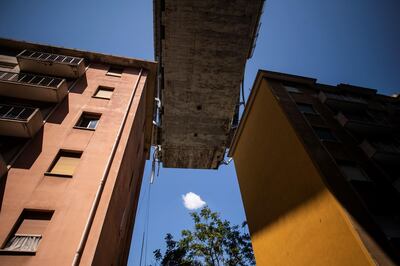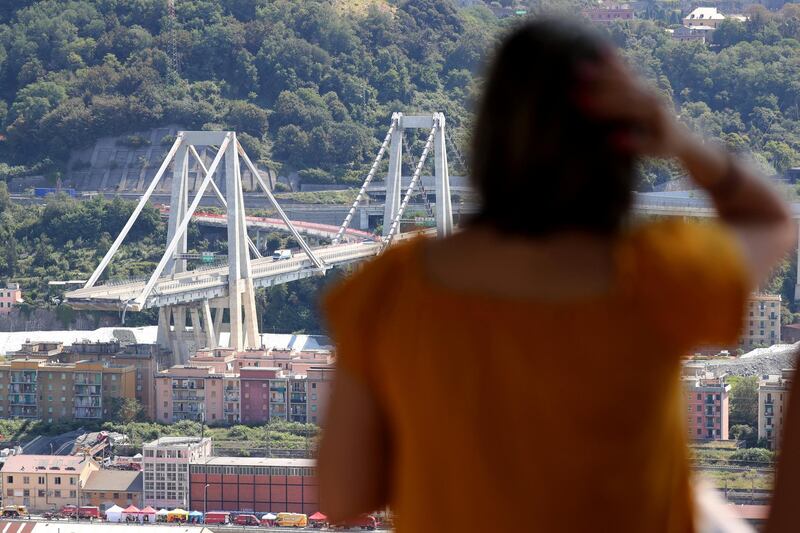In a town perched between hills and the sea and built on a web of bridges and flyovers, the morgue of Genoa’s San Martino hospital was filled on Thursday with grieving relatives of victims of the collapse of the Morandi bridge two days before.
The deaths of 39 people, with up to 20 more still missing, has been hard to absorb both for those directly affected and the country as a whole.
"It could have been anyone of us," a relative of one of the victims, who asked not to be named, told The National.
His brother-in-law, Antonio Stanzione, was travelling on holidays with three other friends in their 20s, from the southern town of Torre del Greco to the French city of Nice.
“They were supposed to go on holiday in the south of Italy, but they changed their mind last minute and decided to go to Nice instead,” the relative said.
Matteo Bertonati, one of the victims who died alongside Stanzione, had suggested the trip to Nice, where his sister had a house. The twist of fate sealed their doom.
Toto Toralbo, 29, spoke of his friend of Giovanni Battiloro, who had died, and his volunteer work last year with rescue crews after a fire in Italy’s south.
"We gave assistance to the emergency units as volunteers when the fire started at the Vesuvio in 2017," Mr Toralbo told The National. "He always fought for civil rights … he did not give up but this is a country that does not repair its bridges, this is a country that does not protect its youth."
Grief at personal loss is accompanied by political anger at the state of the country. Mr Toralbo has taken to social media to demand justice.
Following the collapse, the government said it would terminate the contract of the highway operator, Autostrade per l’Italia, which is responsible for road safety. The company’s shares fell almost 30 per cent on Wednesday following the government’s announcement.
The Benetton clothing family, who own the biggest shareholder in Autostrade per l’Italia, came under fire for not investing enough in public infrastructure. A picture of the bridge with the Benetton slogan, “United Colours of Benetton”, is doing the rounds on Twitter.
Marco Caciotto, political analyst at the University of Milan, said that the disaster at the Morandi Bridge had been pounced on by Italy’s populists.
_______________
Read more:
[ Little hope of more survivors in Genoa bridge collapse as 39 confirmed dead ]
[ Italian road conglomerate Altantia's shares hammered on bridge collapse ]
_______________
Interior Minister Matteo Salvini of Italy’s eurosceptic League party has declared the failure of the bridge must be a turning point. Mr Salvini wants to increase investment in infrastructure and hinted that EU spending limits could put lives at risk.
“If external constraints prevent us from spending to have safe roads and schools, then it really calls into question whether it makes sense to follow these rules,” Mr Salvini said. “There can be no trade-off between fiscal rules and the safety of Italians."
However brave the political rhetoric has become, Italy is unlikely to shake off the constraints on its budget anytime soon.
“Italy has a huge public debt,” said Mr Caciotto. “A politician can do one of two things: either he admits he can’t do anything, or he blames someone else.”

Besides the families of the dead and those injured, the disaster will affect hundreds of thousands for months and years to come. Not only is one of the main north-south traffic arteries in the country broken, but at least 600 people have been evacuated from homes under what is left of the bridge.
The Kromer family does not know whether they will ever be able to return to their home. "We were told to take things for two days, but now it looks like we won't be able to go home," Adriana Monaco Kromer, 58, told The National.
Genoa’s mayor, Marco Bucci, said “it will be difficult to save those houses under a bridge that might have to be taken down,” and said residents will be the “number one priority.”
Ms Kromer said she did not have much faith in the municipality taking care of them. “Maybe they will pay us for a hotel for a few weeks, but in the long term, what will we do?”
At a makeshift reception centre, treatment is available for those traumatised by the bridge collapse.
Maria Tini, 58, a volunteer doctor, said many of the people she had assisted had abandoned their cars on the bridge. “There is one man from Ravenna who is suffering deep shock,” she said. “He suffers from frequent panic attacks and says he feels like he is being dragged down into the void with the others.”
Genoa’s recovery, she added, would be a great deal more complicated than the cost and complexity of building a new bridge.
_______________
Genoa bridge collapse: Rescue workers search for survivors - in pictures






